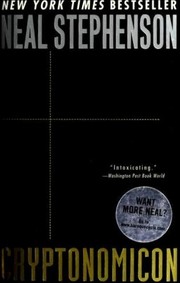On Cryptonomicon
Posted by Jack on 2023-04-02 at 13:30Tagged: books

| Title | Cryptonomicon |
| Author | Neal Stephenson |
| Published | 1999 |
| ISBN | 9780380788620 |
I almost never re-read books, but this time I made an exception. I read Cryptonomicon right before I graduated high school circa 2004. My friend Frank, with whom I was doing a senior service project, loaned me his copy to read while the kids we were ostensibly helping were expected to do quiet work. He'd also loaned me Snow Crash previously and generally helped turn me into a cyberpunk and Stephenson fan. Thanks, Frank.
I decided to re-read Cryptonomicon because, a few years after reading it the first time, I made an abortive attempt to read Stephenson's Baroque Cycle books, and since then those three tomes have been re-released as eight separate books that are more focused in nature. Reading them is my end goal, and even though Cryptonomicon isn't part of the cycle itself, it's clearly a related work. I also wanted to re-read Cryptonomicon because I feel old. I was a fresh-faced teen when I read it the first time, now I'm basically a version of Randy Waterhouse... a UNIX guru that works in tech in my mid- (or now late-) 30s.
Half way through this book, I was really enjoying myself and I was reconsidering reading the split Baroque Cycle books. I was theorizing that as a much more accomplished reader with a better handle on the history Stephenson covers I might be able to deal with the interlacing of three basically unrelated stories a little better than before, since Cryptonomicon did its story weaving well enough. By the end of Cryptonomicon, I reconsidered the reconsidering. I enjoy Stephenson's style of writing very much, I don't mind being taken on wide tangents to illuminate some facet of a character, but it was around the time that we started getting into long tangents about ejaculation frequency and a trip into the jungle that's told in a twenty page email (tangents within tangents) that I felt my patience being tested.
The tangents felt especially annoying at the conclusion of Cryptonomicon because, like Stephenson's Anathem, the story sort of... stops, just as it's gotten to the most interesting part. In this case, our present timeline heroes finally achieve their business goals, which is painted as this huge societal upheaval, but exploring any sort of immediate consequence of that upheaval is left as an exercise to the reader. Stephenson hints at it, there are protesters and counter-protestors (that show up in the middle of a jungle no less), Randy Waterhouse is on magazine covers, etc. but not even one paragraph is spent after it becomes clear the main characters "won". I suppose this is a less damning criticism than it sounds because the 40s era timelines all conclude nicely precisely because we can see 50 years into the future.
However, most of what I enjoyed in Cryptonomicon the first time was amplified this time, and I do believe I had a better experience on this re-read. I was pleased to find that I remembered a lot of the extant points in the novel, but after 20 years not so many that I felt bored. I think I derived more enjoyment from the math portions of the book this time, being more familiar with series notations and vectors etc. but also being less impatient to get to "action". The Waterhouse and Goto Dengo chapters felt a lot less dry.
Bobby Shaftoe's story was still a highlight but for different reasons. The chapters are clearly the most pulpy action, but the passages also let Stephenson play with the narrative in surreal ways, as Shaftoe drifts in and out of tortured sleep, morphine withdrawal, or just a boring conversation.
I also immensely enjoyed the UNIX aspect of Randy's storyline. At 18 I was already a Linux user and got a big kick out of the book's hacker terminal cred. I largely found its tech basis to be still really solid in 2023. It's fun how much stuff that was real and cutting edge in 1999 is so commonplace today. I remember distinctly being jealous of Randy's wireless internet ("packet radio") on his expensive laptop and today we have WiFi enabled everything. I also love than Van Eck phreaking is applied practically, it's a great example of how security gets complicated when thinking about computers as physical objects with physical properties rather than as black boxes that can only be attacked via code exploits.
Let's also take a moment to debunk something I frequently read on the internet when Cryptonomicon comes up. The Epiphyte(2) currency is not Bitcoin. It's cryptocurrency adjacent, but what Stephenson is describing is far more conventional. It's entirely centralized. It's backed by gold for Chrissake. That said, what he's describing is actually more useful than Bitcoin for that reason. If you can trust a corporation (and Epiphyte(2) is probably as close to a perfect storm for me personally as could exist, being run by freedom-minded UNIX crypto geeks - although Google is a big counterexample of well meaning techies gone wrong), then their currency could actually be anonymous, stable and not based on wasting colossal amounts of energy "mining". Epiphyte(2) is crypto PayPal with a data haven attached.
This re-read has definitely made me consider reading some other works from my younger days. Particularly Stephenson's own Snow Crash, which would probably be interesting now that I've read William Gibson's Sprawl Trilogy (among other cyberpunk works) and the idea of the metaverse has re-entered the public consciousness.
As for Cryptonomicon itself, it's still a great work and holds up really well after 20 years of advancement. It's a hard book to recommend to the average person because it's hard to gauge how interested people would be in reading about theoretical underpinnings of cryptology, or the history of the information theory etc. but for anyone technically minded this is a lot of fun.
